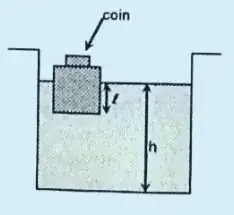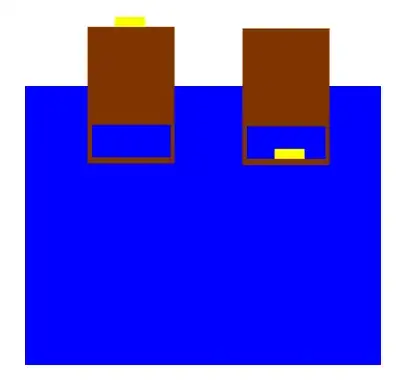Based on the wording of your question as well as some of your comments, it seems as though you believe that the amount of liquid displaced by a submerged object is related to the weight of the object. It is not.
If a coin is submerged in water, it will always displace the exact volume of water that is equivalent to its own volume. Whether the coin is perfectly weightless or it weighs a million tons, the amount of water displaced will be the same as long as the volume of the coin is the same. Even if the coin was lighter than the water and was being held under the water by some force, the displacement would be the same. It also does not matter whether the coin is resting on the bottom, in the process of sinking, or glued to the side of the container as none of those factors are related to displacement at all.
In terms of the explanation for why the water level drops, since the water is less dense than the coin, when the coin is placed on top of the box the volume of water displaced is the amount of water which equals the weight of the coin. Compare that to when the coin is dropped in the water, during which time the amount of water displaced is the same as the volume of the coin only. Since the amount of water which equals the weight of the coin is greater than the amount of water which equals the volume of the coin, the amount of displaced water is greater when the coin is resting on the box.
This may have contributed to the confusion regarding the relationship between weight and displacement, but remember that the only reason weight matters when the coin is on top of the box is because its affecting how much of the box is pushed into the water. once the object is completely submerged, weight ceases to have any impact on displacement.
finally, this was briefly mentioned in a comment, but it may be easier to visualize whats happening if we exaggerate the parameters. Imagine if instead of a coin, we used a tiny metal cube made of some hypothetical material which is far heavier than any element but only takes up one cubic millimeter of volume. If we drop the cube into the water, exactly one cubic millimeter of water will be displaced. However, if we place it on the box then a huge portion of the box will sink under the surface, displacing far more than a cubic millimeter of water.
Edit based on the edit in the question: Under the majority of circumstances, water is, for all intents and purposes, incompressible. At the very last, the compressiblility of water can be ignored for problems like this. The fact that water does not compress is actually one of the big reasons why it is displaced upwards in the first place. When you place the box in the water, it can not compress so it must instead move somewhere else. In the case of this problem that "somewhere else" is upwards into the empty space at the top of the container.

